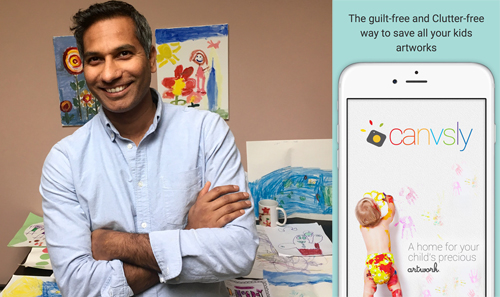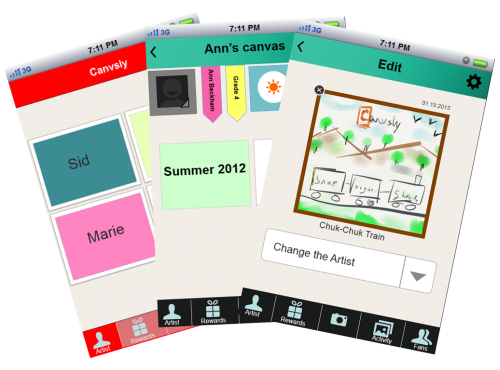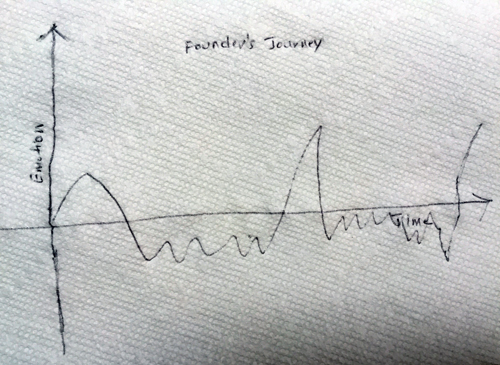Lessons Learned From A First-Time Appreneur
There are over 2 million iOS apps and almost as many Android apps, in a growing app economy. However, for every Flappy Bird app that gets lucky and goes viral, there are thousands of apps that take time and hard work to launch, and persistence to maintain, grow and avoid the app graveyard. While we typically hear about overnight success stories, this article explores the more typical experience of an appreneur, or app entrepreneur.
I spoke with one such appreneur, Amit Murumkar, about his journey with Canvsly over the past 3 1/2 years. Canvsly helps parents capture and store their children’s artwork for posterity and avoid the piles of paper.
Amit independently funded the iOS app for two years until it became self-sustaining, and experimented with different monetization strategies until he settled on revenue sharing from services. Not being a developer, he outsourced development only to learn the hard way that building a team with some skin in the game is the best long-term approach. His guerrilla marketing tactics paid off but also got him kicked out of a mall. And while he won’t be quitting his day job anytime soon, he is bullish on upcoming plans with Android and expansion in foreign markets.
The conversation excerpts that follow highlight ten lessons for first time app entrepreneurs, which I hope will be helpful for readers who are considering a similar journey.

Amit Murumkar, first time appreneur of Canvsly.
1. Prototype, Validate, Iterate
Amit, what sparked the idea for Canvsly?
In Oct 2012, our company intranet hosted a competition for art created by employee’s kids. Clicking through the entries, what struck me was the pride employees had in showcasing their children’s drawings and the sense of community that it generated. My daughter was 3 at that time, and would bring art back daily from her Montessori school, but there is only so much you can put on a refrigerator door. It saddened me that I didn’t have any of my childhood artwork saved. All these triggers made me realize that many parents like me had a need for, and would appreciate a way to capture, store and share their kid’s artwork.
The saying “necessity is the mother of invention” certainly holds true in this case. How did you bring your idea to life?
I built a simple prototype in a few evenings using PowerPoint and Keynotopia and showed it to friends at a Diwali party the following month. Looking back, it is embarrassingly rough, but it presented a visual concept on how you could capture, organize and share your kids’ artwork, and everybody loved it. That set the ball rolling.

Early prototype of Canvsly created in PowerPoint.
That counts as guerrilla user research. What about any competitive analysis?
[Laughs] I ran one search on the AppStore for “storing kids art” and did not find anything. I mean there were public apps like Instagram, but those are not secure. I took that as a sign to go full steam ahead, and started building the iOS app.
What made you start with iOS?
I was bootstrapping this app with my own funds, so I knew I couldn’t create both apps. I did some searching and found that iOS was a better platform for me to start with. For one, at that time, there was one OS, one screen size, and no fragmentation like the Android market, making it easier to develop and that was my primary consideration. I had also read that my primary audience, largely soccer moms with a certain demographic and lifestyle, used iOS devices. Lastly, the probability of developing a business out of an app was higher on iOS than Android.
2. Build The Right Team
You mentioned that you’re a product guy, not a developer. How did you go about building the app from the prototype?
I think I could have coded it if I wanted to learn coding, but that would mean time spent learning how to code. I initially tried putting together a small team here, but that fell through after a few weeks. That was my first big failure – not building a team. I regret that when I think of the domino effect of not starting with a team. Solo founders without a team, however small, have an extremely difficult time getting funding. If I had funding, I could have done so much more with the app. To keep things moving, I started looking for someone I could pay to build it. Being on a limited budget, the cost efficient way seemed to be offshoring design and development. Google helped me find a few options, and I ended up selecting one of them based on a gut feeling. However, offshoring came with its own challenges. If I had to do it all over again, I would spend more time assembling a core team — that’s what I did before launching the Android app.
3. Begin With A Minimum Viable Product
When you say challenges, are you referring to the typical communication issues, or anything else?
Communication over distances and time zones was a small factor. I had thought through the core features and would think of improvements as it was being developed. However, the quoted cost was strictly based on my initial prototype, and any changes came with a price tag. For example, the changes I had to make based on consistent feedback from family and friends during beta testing. In hindsight, outsourcing is a good way to experiment with a Minimal Viable Product (MVP), without any bells and whistles. If the app gets traction, assemble a team to add other features – Skype is one such success story.
4. Have A Monetization Strategy
You bootstrapped your way through user research, design, development and testing. What about the big M — Monetization?
I didn’t want to display ads in the app — I personally feel they destroy the experience of the user. I was also looking for ways to engage and reward users to keep them motivated. I introduced badges for kids, and when trying to find ways to reward parents, I stumbled upon Kiip, a mobile advertising network. Instead of displaying ads in the app, they reward app users for reaching different milestones or moments of pride. These are real world gifts like store gift cards and mp3 downloads that are a clever way to advertise for a brand without becoming intrusive. At the time they were running a competition for innovative uses of their reward system. They loved the app concept and we were expanding their audience to parents, instead of young gamers. Just a week before launch, they informed me that Canvsly won the Kiip Build Fund Award which was $10,000 cash award and $5,000 in services! They coincidentally announced the award winners in TNW (The Next Web) on the day we launched, giving us a boost. I had a few ups and many downs on my journey, and this was one of the big ups!
5. Marketing On A Budget Needs Creativity, Time & And Persistence
Nice! That also jumpstarted the other M — Marketing. How did you create awareness and promote Canvsly?
This is where I had the least experience, no network and most importantly no big marketing budget. When you are bootstrapped, you have to be creative. I used 3 things for marketing – social media, traditional media and guerilla marketing. I made a facebook page and started creating initial buzz 3-4 months before launch. I knew about the power of Twitter but was not an active user so I started building an audience on Twitter as well.
I soon realized that I would need a bigger bang than this to make an impact. The app needed to be covered by a parenting-related magazine or a tech blog with a large audience. So I made a list of about 50-60 journalists who wrote about family and parent related apps and cold-emailed them a write up and screenshots. Only one wrote back — from TechCrunch. I couldn’t have asked for a better platform! When the app was covered by TechCrunch, other media also started taking notice, and over time the app was covered by newspapers and local TV stations.
Finally, I did a lot of guerilla marketing locally, including leaving flyers everywhere I could — I even got kicked out of my local mall for distributing flyers. I also held art competitions at our dentist, and my daughter’s pediatrician.
Hold on — go back to what you were saying about getting kicked out of the mall. What happened?
[Smiles] The iPhone 5s launched the month after our app went live. There was an Apple store in a nearby mall, so I went there the day they started selling the 5s and began distributing app flyers to the people who were lined up. I was halfway through the line when security rode up on their Segways and “escorted” me out of the mall for soliciting. It was a crazy thing, but an entrepreneur with passion and limited resources gets creative and will go to any length to make it work.
You have a run-in-with-the-law story for the grandkids! How did your family feel about this?
My Dad, a professor, was visiting from India and was with me at the mall. I’m sure it wasn’t his proudest moment, but he did not say anything. My wife was very supportive; I could not have done it without her. I did most of this with a full time job, spending every free hour on the app. I even quit my job for a few months to focus on the app. In fact, my second daughter was born just a few months after the app launch.
6. Monitor Your App & User Feedback
You essentially had two babies born a few months apart! What did you do to nurture and grow your app child?
My app child! I was a single parent of Canvsly, playing the role of a product owner, marketing, PR, sales and customer support among others. But that also helped me keep my finger on the pulse of what users like and don’t. I monitor App Store feedback, emails that came in with complaints and feature requests. Analyzing and acting on analytics is another important activity. For example, we used to have the print pictures option at the top of the screen, and analytics showed us that users never clicked it. They only clicked the tabs at the bottom. We moved it to the tab bar and people started placing orders. Another request we heard was for worldwide shipping — so people could ship prints and photo products to their families anywhere in the world, and we found a partner to enable that.
Analytics are an important feedback tool – what do you use for analytics?
I started off using Localytics since that was part of the Kiip Build Fund Award. I also started using Woopra, and we recently built our own internal analytic tool to better understand our users.
7. Supporting Services Are An Easy Way To Bring In Some Money
How did you find the right partners?
Everything is and should be driven by customers. I initially offered photo prints through FujiFilm, but they only shipped within the U.S. Our users were across the globe and constantly reminded us that they would like to create keepsakes too, so we had to find another partner who could offer us worldwide shipping capabilities. We also added Walgreens because of the convenience of being able to pick up prints the same day in their stores. The app is now self-sustaining because of these services.
Does that mean you will be quitting your day job soon?
[Laughs] Not anytime soon! When I said self-sustaining, I meant that it covers its own maintenance and infrastructure costs. I think it’s a long way until the app pays us salaries. Even Instagram and facebook did did not make any money until recently. B2C is a tough space to be in, but we are focused on building a community and making sure the users are happy with our app.
8. Take The Long View
Did you ever lose confidence in the app or feel like giving up?
The thought of giving up has never crossed my mind. A startup is a 3-5 year journey; if you quit before that, you’ve not done it justice. However, there were a lot challenging and trying moments to deal with. The app did not have a good 2014 holiday season, and the little facebook and twitter advertising I was doing didn’t seem to be worth the spend, so I made a decision in 2015 to stop spending my own money on the app and made it a paid download. People still purchased the app, though in smaller numbers. I experimented with pricing and saw how it impacted downloads (we made it free after Vishvas joined). But, for every 10 challenging moments, there is at least one moment of joy that will keep you going. For me, these were things like winning the Mom’s Choice Award, being featured by Apple, and even a great review or email from users telling me how thrilled they are to find an app like this!

Amit’s napkin sketch depicting a founder’s emotional journey over time
9. Assemble A Team With Some Skin In The Game
You were a team of one for a long time. How did you get your team in place?
It was a very lonely journey for the first two years, and I tried very hard to find people, or at least one engineer I could work with, since that was a skill I lacked. I attended local Meetups, pitched to startup groups, tried offering incentives to join me, but nothing seemed to work. It finally fell into place with someone who was on my cricket team! Vishvas and I would also keep running into each other on train rides back from NYC. He was from the startup world too and understood what it takes to grow, and most importantly shared the same passion. In a small team, it is very important that the others you work with, share your passion and have some skin in the game. It’s so much better than doing it alone — I have someone I can bounce ideas off, challenge me, and brings his own thoughts and skills. The launch of our Android app was our first milestone together!
What did you do differently for the Android version?
We applied all the learnings from the iOS app and could build the Android version in 6 weeks vs. 9 months for the iOS app! We had all the infrastructure in place, knew which features worked, and there was no learning curve like we had when we started with iOS. This was also because we had the engineering skills in-house this time!
How would you define success and what are your plans to get there?
Success for us is making Canvsly synonymous with kids art – we want to be the largest community for kids art around the world. Our recent Android release will give us a bigger market footprint. We have just released the Android version, which has a bigger market footprint. In the near future, we have strategic plans for the Indian market, which has a very large potential. Our goal is to make Canvsly a one stop shop when it comes to kids art – be it storing, sharing, printing or learning.
10. It’s Never Too Late To Begin
Any words of advice for readers thinking of becoming app entrepreneurs?
- Ideas are a dime a dozen, and they don’t mean anything unless you act on them. So make that leap. Pick something that you’re passionate about and be persistent.
- Secondly, it is a long and lonely journey, and not as glamorous as it sounds, but it is a very exciting journey. So find people to work with who share your passion and have some skin in the game.
- Finally, it will take time, effort and a lot of patience, but you will get the satisfaction of seeing your ideas come to life, and seeing others benefit from it.
- If I can do it, anyone can!
Conclusion
Earlier this year, Donald Rumsfeld, former Secretary of Defense, launched an app at 83, proving that it’s never too late to begin.
To summarize the key takeaways from this conversation:
- Start small with the core features (MVP planning)
- Have monetization and marketing strategies in place well before launch
- Build a cross-functional team with some skin in the game; if you have to outsource instead, be crystal clear about scope
- Monitor your app and user feedback for opportunities for improvement
These lessons were identified from the ongoing journey of one app enterprenuer. The Links & Resources section below has a few other examples. What other lessons would you add from your experience? Please share them in the comments.
Links & Resources
Big Picture & Marketing
Self-Funding, Successes, Failures & Hard Numbers
- 10 Reasons Why I Self-Funded My Startup and So Should You
- How Hours became a top grossing app
- iPhone App Failure: Income, Losses, and Lessons From My First iPhone App
- Overcast’s 2014 sales numbers (“I’m probably coming in under what I could get at a good full-time job in the city“)
- A Candid Look at Unread’s First Year (with a monthly take-home calculation of $1,750/month)
I wrote this article for Smashing Magazine

Leave a Comment